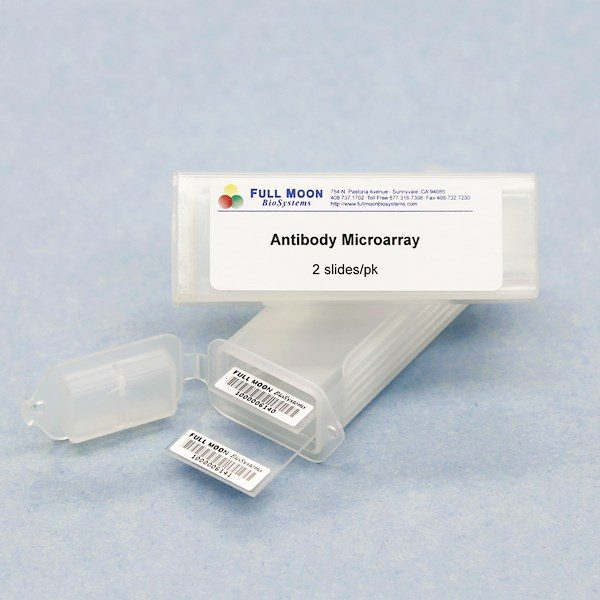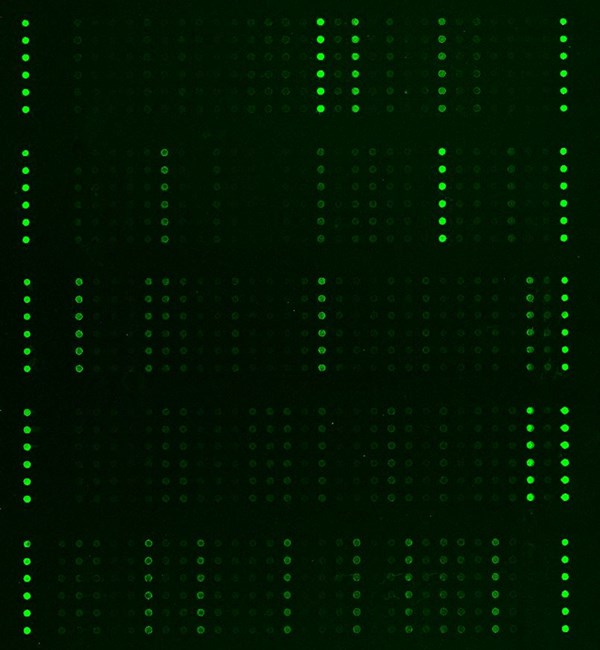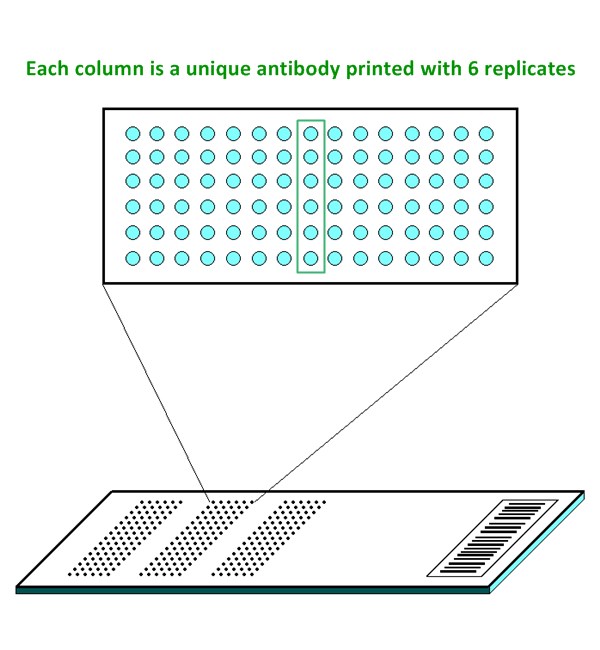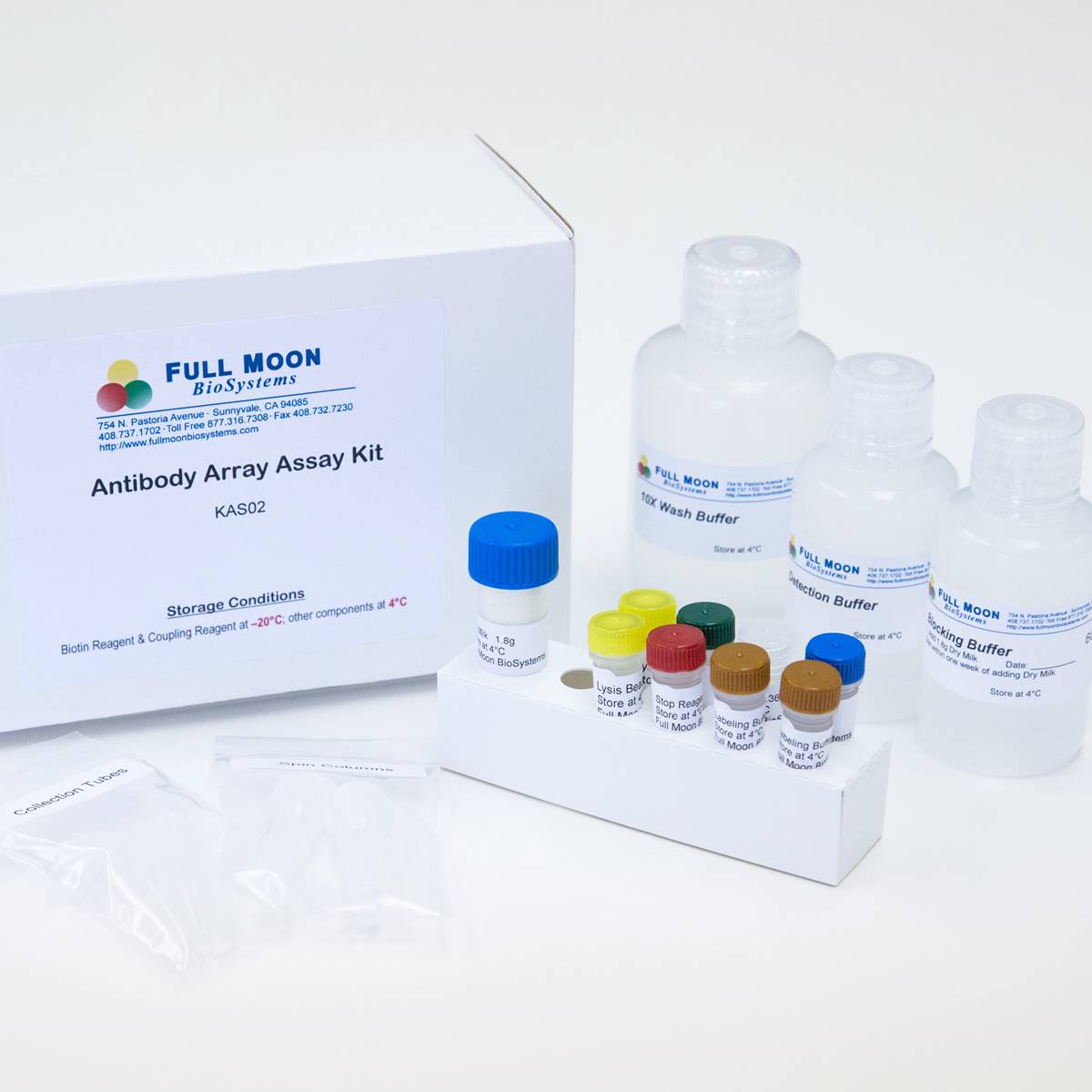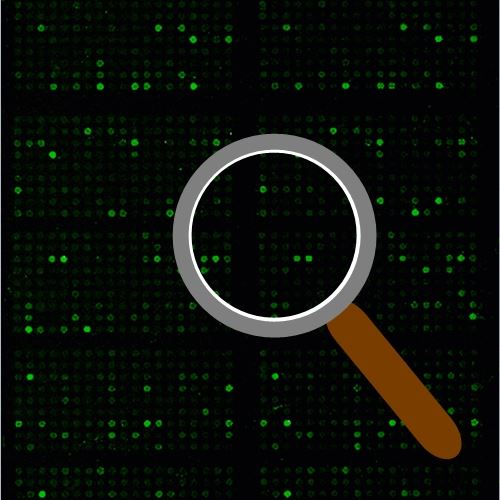EGF Pathway Phospho Antibody Array
EGF Pathway Phospho Antibody Array is a high-throughput ELISA based antibody array for qualitative protein phosphorylation profiling. It is suitable for comparing normal samples to treated or diseased samples, and identifying candidate biomarkers. This array features site-specific and phospho-specific antibodies, allowing researchers to study tyrosine, serine, and threonine phosphorylation at specific sites.
Key Features
- Site-specific phosphorylation profiling and screening with 214 antibodies
- Antibodies covalently immobilized on 3D polymer coated glass slide
- Six replicate spots per antibody
- Fluorescent detection
Specifications
| Product Size: | 2 array slides per package for analyzing two samples (untreated vs. treated) |
| Featured Antibodies: | 214 site-specific and phospho-specific antibodies; 6 replicates per antibody |
| Reactivity: | Human: 100% | Mouse: 96% | Rat: 83% |
| Suitable Sample Type: | Cell lysate | Tissue lysate |
| Detection Method: | Fluorescence | Compatible Scanners |
| Internal Controls: | beta-actin | GAPDH | Negative controls |
| Slide dimensions: | 76 x 25 x 1 mm |
| Storage Condition: | 4°C for 6 months |
Product Details
AKT (Ser473), AKT (Thr308), AKT (Tyr326), Catenin beta (Ser33), Catenin beta (Ser37), Catenin beta (Thr41/Ser45), Catenin beta (Tyr489), Catenin beta (Tyr654), Caveolin-1 (Tyr14), CBL (Tyr700), CBL (Tyr774), c-Raf (Ser296), c-Raf (Ser43), Dok-2 (Tyr299), E-cadherin, EGFR (Ser1070), EGFR (Thr678), EGFR (Thr693), EGFR (Tyr1016), EGFR (Tyr1069), EGFR (Tyr1092), EGFR (Tyr1110), EGFR (Tyr1172), EGFR (Tyr1197), EGFR (Tyr869), EMR1, EMR2, EMR3, ERK1/2, ERK3 (Ser189), ERK8 (Thr175/Tyr177), FAK (Ser910), FAK (Tyr397), FAK (Tyr407), FAK (Tyr576), FAK (Tyr861), FAK (Tyr925), Gab1 (Tyr627), Gab1 (Tyr659), GRB2 (Ser159), HER2 (Tyr1221/Tyr1222), HER2 (Tyr1248), HER2 (Tyr877), IKK gamma (Ser85), IKK-alpha (Thr23), IKK-alpha/beta (Ser180/181), IKK-beta (Tyr188), IKK-beta (Tyr199), IKK-gamma (Ser31), IP3KA, IP3KC, IP6K2, IP6K3, JAK1 (Tyr1022), JAK2 (Tyr1007), JAK2 (Tyr221), JNK1/2/3 (Thr183/Tyr185), JNKK, MAP3K1/MEKK1 (Thr1381), MEK1 (Ser217), MEK1 (Ser221), MEK1 (Ser298), MEK1 (Thr286), MEK1 (Thr291), MEK2 (Thr394), MEKKK1, MEKKK4, MKK3 (Ser189), MKK3/MAP2K3 (Thr222), MKK6 (Ser207), MKK7/MAP2K7 (Ser271), MKK7/MAP2K7 (Thr275), p44/42 MAPK (Thr202), p44/42 MAPK (Tyr204), PAK1 (Ser204), PAK1 (Thr212), PAK1/2 (Ser199), PAK1/2/3 (Thr423/402/421), Paxillin (Tyr118), Paxillin (Tyr31), PDK1 (Ser241), PI3K-p85-alpha (Tyr607), PI3K-p85-alpha/gamma (Tyr467/Tyr199), PIP5K, PKC pan activation site, PLCG1 (Tyr1253), PLCG1 (Tyr771), PLCG1 (Tyr783), PLCG2 (Tyr1217), PLCG2 (Tyr753), Rac1/cdc42 (Ser71), Raf1 (Ser259), Raf1 (Ser338), Raf1 (Ser621), Raf1 (Tyr341), RAS (p21 H&K), RASE, RASF4, Ras-GRF1 (Ser916), Rho/Rac GEF2 (Ser885), SAPK/JNK (Thr183), SAPK/JNK (Tyr185), SEK1/MKK4 (Ser80), SEK1/MKK4 (Thr261), SEK1/MKK4/JNKK1 (Ser257), Shc (Tyr349), Shc (Tyr427), Src (Ser75), Src (Tyr216), Src (Tyr418), Src (Tyr529), STAT1 (Ser727), STAT1 (Tyr701), STAT3 (Ser727), STAT3 (Tyr705), VAV1 (Tyr174), VAV2 (Tyr142)
The ELISA based EGF Pathway Phospho Antibody Array platform involves four major steps:
- Protein extraction with non-denaturing lysis buffer
- Biotinylation of protein samples
- Incubation of labeled samples with antibody array
- Detection by dye conjugated streptavidin
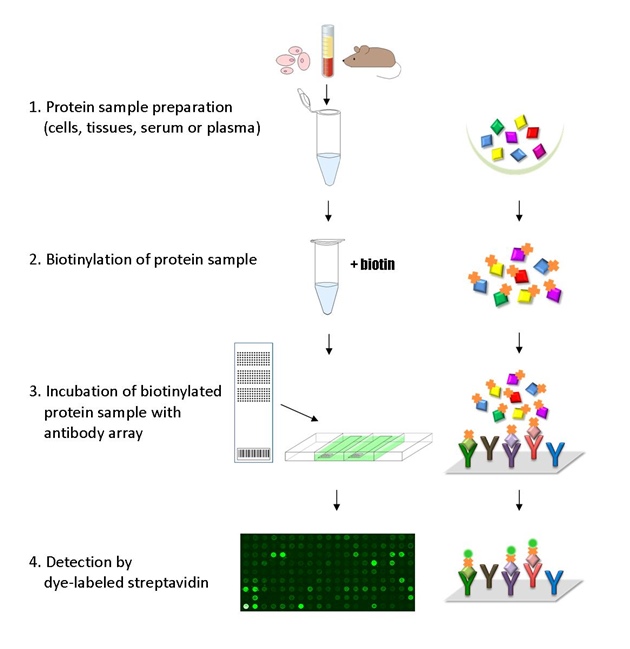
Kiso-Farne K, Tsuruyama T, Epidermal growth factor receptor cascade prioritizes the maximization of signal transduction, Sci Rep. 2022 Oct 10;12(1):16950
Tsuruyama T, Kullback–Leibler Divergence of an Open-Queuing Network of a Cell-Signal-Transduction Cascade, Entropy 2023, 25(2):326; https://doi.org/10.3390/e25020326
Shields S, Conroy E, BAG3 promotes tumour cell proliferation by regulating EGFR signal transduction pathways in triple negative breast cancer, Oncotarget, 2018 Mar 20; 9(21): 15673–15690.
Services
If you don’t have access to a microarray, send the finished arrays to our lab for scanning. Raw scan images are delivered in tiff format.
Cost: Free
Array Image Quantification and Analysis Service includes data extraction, data organization and analysis of the array images obtained through our array scanning service.
Cost: $250 per slide
Complete Antibody Array Assay Service allows investigators to send research samples to our laboratory for analysis. There is no need to purchase the arrays and reagents and running the assays yourself. Simply select the array of your choice, and then send off the samples to our lab. This convenient hands-off approach offers quick turnaround and reliable results, saving you valuable time and resources. All assays will be performed by our highly trained scientists at our headquarter in Sunnyvale, California. Results are delivered by email in 1-3 weeks.
Cost: $1,520 per sample

